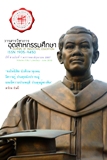การศึกษาเส้นทางเดินรถในการเคลื่อนย้ายผู้ประสบอุทกภัยออกจากพื้นที่อันตรายเมื่อระดับน้ำสูง กรณีศึกษา: ตำบลลาดสวาย อำเภอลำลูกกา จังหวัดปทุมธานี
Abstract
บทคัดย่องานวิจัยนี้เป็นการศึกษาเส้นทางการเดินรถในการการเคลื่อนย้ายผู้ประสบอุทกภัยออกจากพื้นที่อันตรายเมื่อระดับน้ำสูง ในระดับที่ไม่สามารถใช้รถยนต์ส่วนบุคคลในการอพยพได้ ซึ่งในกรณีนี้จำเป็นต้องใช้รถที่มีขนาดสูงเพื่อเคลื่อนย้ายผู้ประสบภัยออกจากพื้นที่อันตราย ทำการหาเส้นทางที่เป็นคำตอบโดยใช้วิธีการแบ่งพื้นที่ออกเป็นกลุ่มก่อนจัดเส้นทาง (Cluster-First Route-Second) และวิธีการเปรียบเทียบการประหยัด(Saving Algorithm) โดยมีวัตถุประสงค์เพื่อให้ได้เส้นทางการเดินรถที่มีระยะทางในการอพยพรวมต่ำที่สุด พื้นที่กรณีศึกษาคัดเลือกมาจากบริเวณที่มีปัญหาน้ำท่วมรุนแรงในปี 2554 ได้แก่ ตำบลลาดสวาย อำเภอลำลูกกา จังหวัดปทุมธานี ซึ่งมีจำนวนประชากร 46,921 คน โดยสัดส่วนของผู้อพยพคิดเป็น 10% ของจำนวนประชากร แบ่งโซนในการอพยพออกเป็น 6 โซน ตามถนนสายหลักที่สามารถเชื่อมต่อไปยังสถานที่ปลอดภัย ในการขนย้ายผู้ประสบภัยออกจากพื้นที่อันตราย ทำโดยใช้รถจีเอ็มซี 1 คันต่อโซน ผลการศึกษาพบว่า เส้นทางที่ได้จากวิธี Cluster-First Route-Second มีระยะทางรวม 1,442.73 กิโลเมตร ส่วนเส้นทางที่ได้จากวิธี Saving Algorithm มีระยะทางรวม 909.39 กิโลเมตร คำสำคัญ: ปัญหาการกำหนดเส้นทางเดินรถ, วิธีการแบ่งพื้นที่ออกเป็นกลุ่มก่อนจัดเส้นทางวิธีการเปรียบเทียบการประหยัด, อุทกภัย Abstract This research was a study to vehicle routing problem for evacuating the flood victims out of the affected area when the water level is high, at which personal cars cannot be used. In this situation, only special high vehicle was needed for driving through flooded roadway to evacuate the people out of the hazard area. The vehicle route was investigated based on the two methods, which are Cluster-First Route-Second and Saving Algorithm. The objective is to minimize total traveled distance. A case study was selected based on the severe flooding areas in 2011, Ladsawai Sub-District, Lumlukka District, Pathumthani Province with a total population of 46, 921 people. The number of evacuees is fixed at 10% of the total population. We divided the area into 6 zones, based on the main road connected to safe places. The GMC is selected for transport evacuees out of the affected area, using 1 vehicle per zone. The result showed that Cluster-First Route-Second yielded total distance of 1,442.73 km. while Saving Algorithm yielded total distance of 909.39 km. Keywords: vehicle routing problem, cluster-first route-second, saving algorithm, flood disasteDownloads
Download data is not yet available.
Downloads
Published
2014-06-28
Issue
Section
บทความวิจัย







